… this made me very sad.
http://thegoglog.blogspot.com/2011/03/remains.html
Fri 18 Mar 2011
Thu 17 Mar 2011
R. A. J. WALLING – The Dinner-Party at Bardolph’s. Jarrolds, UK, hardcover, 1927. Hardcover reprint; Hodder & Stoughton, 1937. US title: That Dinner at Bardolph’s. Morrow, hc, 1928. Series character: Inspector Pierce.
A few years ago (certainly more than five, probably less than ten) I was walking past my local library and saw outside a trolley of books for sale. They consisted of tatty, much read recent books but amongst them was this title in a 1937 Hodder & Stoughton edition. It clearly wasn’t from the library itself — it’s far too old and had no library stamps — so I guess it must have been some sort of donation though I haven’t really heard of that happening over here (though I think it is common in the US).
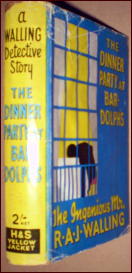
Anyway for the sake of 30p I couldn’t really leave it there so, against my better judgement, I forked over the cash and brought it home to join the thousand or so other books awaiting my attention.
It might have stayed in the loft forever, or until my executor starts disposing of the contents, but Barry Pike had an article on another Walling book in the current issue of CADS (that well known literary magazine) and I was inspired to fish it out and give it a try.
And I’m glad I did. In many ways it was dated and slow-moving, the whodunit element was not particularly cunning, and the actions of the narrator a gentleman of the old school – were hard to credit, yet it was fascinating and held my attention well.
The story involved the death by shooting — at first assumed to be suicide — of the titular character and the subsequent disappearance of all the dinner guests. The narrator and his hardworking factotum-cum-chauffeur are involved in the clandestine movements of two of them but when murder is uncovered they become caught up in a chase to clear the names of the innocent and find out what is behind the crime.
And, as I said, it all worked — for me anyway. I probably won’t go actively searching out more Walling’s to read — I have so many other books piled up and clamouring for my attention, but if I come across one in a second hand book shop I will probably pick it up.
Editorial Comment: Geoff mentions in passing the existence of a mystery fanzine called CADS, but he failed to point out two things. First of all, that he is the editor and publisher, and then secondly, that the magazine is still going strong.
If you’re interested in articles about authors and reviews of mystery fiction that are both solidly and substantially done, you should most definitely be reading CADS. The most recent issue was #59, and copies should still be available at a cost of $14 by air or $12 by surface mail. #60 will be ready in a few weeks, says Geoff, but since postage fees will be going up in early April, the price hasn’t been determined yet.
Geoff’s mailing address can be found here, but the ad’s way out of date. Email Geoff to double check on the availability of #59 or to reserve a copy of #60. (Tell him I sent you.)
Thu 17 Mar 2011
In the world of fiction, there is a black door. The door stands alone. To its left is a beautiful garden lit in soft focus sunshine. To its right, ugly weeds force themselves up through broken concrete in the blackest of night. Open the door and you will find yourself in the Home of Mystery.
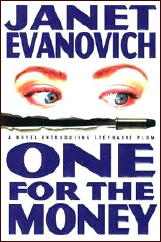
Designed from plans stolen from the Doctor in the Home of Science Fiction, it is larger inside than outside. The Home of Mystery is endless and defies all laws of science. Sub-genres merge and separate. Writers, characters, and books can exist in more than one place at the same time.
I head for the comedy mystery wing, a multi-floor structure. The classic era is on the bottom floor, but I take the stairs to the modern era one floor above.
I am in a hallway, cozies to my left, hardboiled to my right. I look to my left and pass doors for other sub-genres, “little old ladies,” “pets,”, and “special interests.” Finally, I see a lavender door covered by a cartoonist drawing of a thin perky young female in a short dress. I have found what I was looking for, the Modern Romance Comedy Mystery. I knock.
A pretty Heroine greets me. She stares at me suspiciously and tells me that Men’s Adventure Pulp is across the hall. I explain how much I enjoyed Hailey Lind’s (Julie Goodson-Lawes and Carolyn Lawes) “Art Lovers” series featuring former art forger Annie Kincaid, and I wanted to learn more about MRCM. Reluctantly, she let me in.
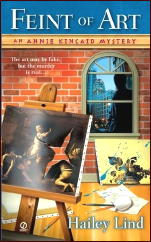
The room is full of more light and color than I am used to in the mysteries I normally read. The place is comedically disorganized and messy, yet clean.
My guide talks about her idol, Stephanie Plum. It is hard not to notice the influence Janet Evanovich’s series has had on MRCM. Plum is a feisty, funny, horny woman with a slow sex life and active sexual fantasy world. As many MRCM books that followed, the books feature a supporting cast of comic relief characters, and a popular romance subplot: the triangle. Stephanie loves good cop Joe Morelli but lusts for bad boy Ranger.
The Heroine mentions New York Times bestselling “Bibliophile” series by Kate Carlisle, but suddenly stops talking, distracted by some bad boy beefcake in skintight leather. After a few uncomfortable moments I walk on. She does not move, unaware I have left.
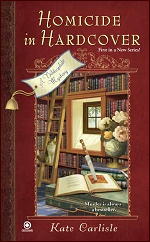
A man and a woman’s screams make me think about Maddie and Jack from the “High Heels” series by Gemma Halliday. The man is a cop and the woman is an amateur detective. Both scream at each other at the same moment, “Mind your own business!”
They are the screwball couple of MRCM, two strong willed people who “hate” each other to the point of falling in love. Predictably, the screaming couple are now in each other’s arms as they fade out of the room. In MRCM, most sex and violence happens off page.
My former guide has not moved. Bad boy beefcake notices her and smiles. Embarrassed, she runs off, bumping into another popular romantic subplot.
Happy Couple is trying to hide in the shadows, content just to be alone together. They remind me of award-winning Donna Andrews’ Meg Langslow and Michael. Happy Couple tell me they had met in her first book and their relationship has grown more serious as the series continued. Spotted, their supporting cast attacks them, odd parents, strange siblings, attention demanding pets, wacky friends, all separating the comically frustrated lovers.
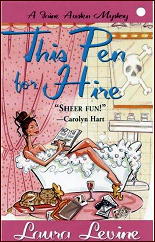
There are endless variations of the romance subplot, from unlucky in love (Jaine Austen by Count Chocula’s creator Laura Levine) to the strange (Kasey Michaels’ Maggie Kelly, mystery writer, who finds the man of her dreams when her fictional hero Saint Just comes to life).
I spot the MRCM femme fatale, the gorgeous blonde bitch who usually annoys the Heroine, but sometimes is the murder victim. Typical of MRCM, she just flirts, teases and then is gone.
I understand why the Heroine thinks more about sex than the mystery. Who cares who the killer is after all this “talk”? Even fictional characters can take only so much. To drive such thoughts from my mind, I think about what makes a Modern Romance Comedy Mystery.
The books are short quick reads, told in first person, the fourth wall is often ignored, the heroine’s life is threatened, and the victim often deserves to die. The characters’ lives are more important to the story than the mystery. The characters change and grow as the series progresses. It is wise to read an MRCM series in order.

The female amateur detective gets involved because of one of the following: she is the main suspect, she knows the main suspect, she feels responsible for the accused problems, the cops are idiots and/or order her to go away, the killer is after her, or she keeps falling over dead bodies.
Sales have moved many MRCM series from original paperbacks to hardcover releases, such as Nancy Martin‘s “Blackbird Sisters.”
Of course there is my reason for reading them: they are funny. From pun titles, such as Slay It with Flowers by Kate Collins, to some of the funniest comedy in fiction today, the MRCM are fun to read.
Still suffering from my encounter with the MRCM femme fatale, I think I’ll pick up one of the bimbos across the hall in Men’s Adventure Pulps.
Thu 17 Mar 2011
THE LADY. Norma Talmadge Film Corp., 1925. Norma Talmadge, Wallace MacDonald, Brandon Hurst, Alf Goulding, Doris Lloyd, Marc McDermott, Paulette Duval. Screenplay by Frances Marion. Director: Frank Borzage, director. Shown at Cinefest 28, Syracuse NY, March 2008.
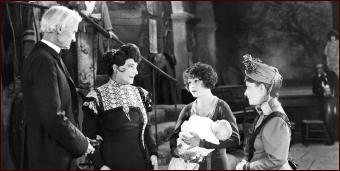
Polly Pearl (Norma Talmadge) marries the dissolute son (Wallace MacDonald) of a British aristocrat. The father disinherits his son who gambles away what remains of his money in Monte Carlo and dies, leaving Polly with an infant son.
She is singing in a Marseilles dive when her father-in-law turns up with his lawyer and attempts to take custody of the child. Polly entrusts the child to a British couple (a curate and his wife) and then spends years looking for him. Their reunion leads to momentary tragedy but the possibility of an eventual happier resolution.
Norma Talmadge shines as the unfortunate Polly and the gifted director handles the unpromising materials with consummate skill, spinning cinematic gold out of straw.
Wed 16 Mar 2011
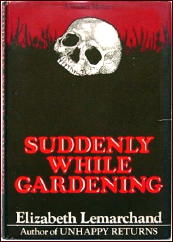
ELIZABETH LEMARCHAND – Suddenly While Gardening. Walker & Co., hardcover, 1978; paperback, 1983. UK edition: Hart-Davis, hc, 1978.
Lemarchand writes the classic (some would say old-fashioned) style of detective story, and this one, about the skeleton of a recently murdered youth found in an ancient gravesite on an English moor, fully demonstrates the blunt, efficient approach she takes to her craft.
Detective-Chief Superintendent Pollard is her detective, and part of what he discovers the title gives away for free. In any case, after all these years, there ought to be a law against accepting broken watches as evidence, of anything, at any time.
That’s what I think.
[UPDATE] 03-16-11. I didn’t happen to mention it in this review, but there were two detectives from Scotland Yard who worked as a team in each of Elizabeth Lemarchand’s mysteries, Tom Pollard and Gregory Toye. When they began Pollard was an inspector and Toye his sergeant, but when the former was eventually promoted, perhaps Toye was also.
There were 17 entries in the series, beginning with Death of an Old Girl in 1967 (when the author was 61) and concluding with The Glade Manor Murder in 1988. All of them were reprinted in the US, but only a few had paperback editions.
A quick search on the Internet has come up with very little critical commentary on her work. One site devoted to cozy mysteries says of hers: “Very traditional British mysteries, often set in girls’ schools; makes use of English history and archaeology.”
I don’t know for sure — this is the only book of hers that I’ve read — but I think my review may have encapsulated Lemarchand’s approach to detective fiction rather well. While she was obviously not another Agatha Christie, and in spite of the somewhat negative tone to my comments, I wouldn’t mind reading another.
Wed 16 Mar 2011
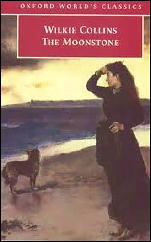
Anna Katharine Green’s milestone American detective novel, The Leavenworth Case (1878), was reprinted last year in an attractive new edition as part of the Penguin Classics series, which now puts the tale in the company of such distinguished nineteenth-century works with detection and sensation elements as Charles Dickens’ Bleak House (1853), Mary Elizabeth Braddon’s Lady Audley’s Secret (1862) and Wilkie Collins’ The Moonstone (1868).
“Some critics disparage [Green’s] characters’ occasional florid speeches” in The Leavenworth Case, admits Michael Sims in his Introduction to the new edition of the tale. Nevertheless Sims contends that while “now and then [Green’s] storytelling [in The Leavenworth Case] is as leisurely as you would expect from a nineteenth-century novel,” the author “keeps the dialogue lively and mostly convincing.”
I would have to dispute Sims’ contention. Except in the effective portrayal of the archetypal “nosey spinster” character, Amelia Butterworth (who appears in three later Green mystery novels), lively and convincing dialogue did not flow easily from the pen of Anna Katharine Green. Indeed, during the numerous high stress situations in Leavenworth, the dialogue, which is never memorable, becomes positively purple (and therefore false), as the character prate like bad stage actors in fifth-rate melodramas:
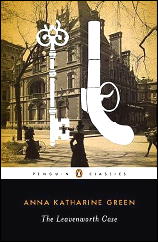
Put simply (as she herself too infrequently put things), Anna Katharine Green was not a scintillating writer. To get to the puzzle plots in her tales, one must wade through shoals of prose that ranges from the merely tedious to the truly tiresome. Even forty years after Leavenworth, as the Twenties roared just around the corner (and with it the Golden Age of detective fiction), Green, in The Mystery of the Hasty Arrow (1917) continued to write unattractively and unpersuasively:
and:
And Green’s characters still have a pronounced tendency to orate, rather than speak naturally, as real-world human beings:
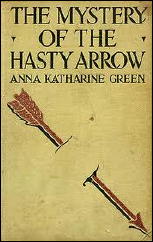
I found Arrow too dully written to bear with over its great length (despite some excellent “multimedia” floor plans that are like something out of one of S. S. Van Dine’s Philo Vance murder cases), yet I wondered about Michael Sims’ implication that the leaden prolixity of Green’s writing simply reflected her literary age. For my part, I certainly had not remembered Charles Dickens and Wilkie Collins being unable to sketch appealing, believable characters.
So for purpose of this review I decided to read three fairly short “sensationalist” works by three Victoran authors: Mary Elizabeth Braddon’s “The Mystery at Fernwood”(1862), Wilkie Collins’ “Who Killed Zebedee?” (1881) and Benjamin Leopold Farjeon’s Devlin the Barber (1888).
In each case I found that, while, the works offered nothing in the way of the more complex detection found in the tales of Anna Katharine Green, nevertheless they each contrastingly offered believable characters and emotionally compelling situations and as a result were vastly more enjoyable to read.
“The Mystery at Fernwood” and “Who Killed Zebedee?” are long short stories (about forty and twenty-five pages, respectively; the latter is also known, more prosaically, as Mr. Policeman and the Cook).
In “Fernwood” Mary Braddon effectively mines the Gothic tradition that had been first struck in Horace Walpole’s The Castle of Otranto (1764) and that perhaps produced it richest early lode of ore with Ann Radcliffe’s The Mysteries of Udolpho (1794). In many of Braddon’s verbose triple-decker sensation novels, appealing mystery elements are too much submerged in love stories (see, for example, Wyllard’s Weird, 1885), but that is not so with the lean and spare Fernwood.
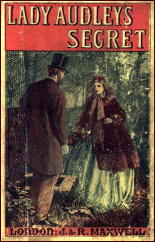
In this tale, a young woman finds not only mystery but grave menace when she visits Fernwood, the decaying Yorkshire country estate of her fiancee. “No, Isabel, I do not consider that Lady Adela seconded her son’s invitation at all warmly,” fatefully announces the heroine’s aunt in the first line of the story.
Academics might strain hard with this tale to find deep meaning about the position of women in Victorian England, but I do not see it myself. However, “Fernwood” is a rattlingly suspenseful tale (even if you pierce the veil of the mystery quickly, as you probably will) and a fine example of the grand and hallowed Gothic tradition that has extended right up to this day in such mystery genre works as Barbara Vine’s The Minotaur (2005).
Wilkie Collins’ “Who Killed Zebedee?” at first seems, with its title and its setting (a lodging house full of eccentric characters), to have popped straight out of the Golden Age of the detective novel (1920-1939), rather than the Victorian era. A frantic cook bursts into a police station, armed with a doleful tale of murder at the lodging house in which she is employed. The victim is one John Zebedee, who was stabbed to death in his bed.
Suspicion immediately falls on Zebedee’s wife, a somnambulist. People fearing a repetition of another Wilkie Collins tale will be pleased to see other suspects emerge among the company of lodgers, most obviously the dandified Mr. Deluc. Desirous of helping the law is the nosy elderly spinster Miss Mybus, yet another interesting early incarnation of a character type most strongly associated today with Agatha Christie’s Miss Marple.
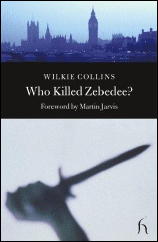
The attention to police procedure and the thumbnail character sketches in “Zebedee” are quite good, making one wish that the tale had been expanded into a full-length novel. As it stands,”Zebedee” is a disappointment as a tale of detection, with the solution coming essentially fortuitously.
To be blunt, “Zebedee” is more luckstone than Moonstone. Collins is more interested here in exploring character, however, and he does this very well, even providing a surprisingly ambivalent ending in the modern fashion.
The only novel among these three works is Devlin the Barber, a striking admixture of mystery and horror elements authored by the prolific novelist Benjamin Farjeon (father of the beloved children’s book writer Eleanor Farjeon).
Luridly advertised on London billboards with an illustration of a young woman bloodily stabbed by a seeming maniac, the book appeared the same year as the Jack the Ripper serial killings horrified England (what are considered to be the genuine Ripper murders took place in 1888 between the dates of August 31 and November 9; Farjeon’s work appeared in serial and book form later that year). Devlin the Barber seems quite obviously to draw not only on the Ripper killings but the gruesome legend of Sweeney Todd, the demon barber.
Devlin the Barber was called a “disagreeable but certainly ingenious tale” when it first appeared and since then has customarily been deemed the best of Farjeon’s many fictional works (only a few of which were sensationalist). Three years before the appearance of Devlin, Farjeon had written Great Porter Square (1885), the first of several praised mystery novels. The man clearly had a talent for crime writing, even though Devlin surely to an extent has to be seen as an opportunistic effort (if an inspired one).
Despite its clear linkage with Jack the Ripper, Devlin opens with only one slaying, that of a nice, middle class young woman who for some reason was keeping a secret late-night rendezvous. After she is found fatally stabbed, it is learned that her twin sister (twins were quite popular in crime books before the Golden Age) has disappeared.
The young ladies’ wealthy uncle, lately returned from Australia, for no particularly compelling reason offers the narrator of the tale, an out-of-work, middle-class friend of the family, a grand sum to solve the case (naturally he has no faith in the police).
The narrator soon finds that the murdered woman had a gentleman friend, but he seems like a winning young man (he is even wealthy and has a responsible guardian). The most striking event occurs, however, when the narrator is called upon for help by his former nursemaid, Mrs. Lemon (could this have been the mother of Hercule Poirot’s future secretary — I certainly hope so). It seems Mrs. Lemon has a very odd lodger indeed, a barber named Mr. Devlin….
Mrs. Lemon’s tale of her frightening lodger, which takes up over a fourth of the book (fifty of the Arno Press edition’s 190 pages), is a tour de force of horror narration. It is almost a disappointment when we come back to the mystery investigation. But now we have a new investigator of the heinous murder: Mr. Devlin himself! If you thought this novel was going to take the same turn of events as Marie Belloc Lowndes’ famous Ripper tale, The Lodger (1913), think again.
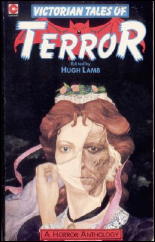
More could be said about this fascinating novel, but I will leave the reader to seek out the book for him/herself. I will simply add that, in contrast with The Leavenworth Case, the narrative throughout Devlin the Barber (published ten years later) is smooth and idiomatic, a reader’s delight. Even the cry of the murdered woman’s beloved is not nearly so melodramatic as the contrived speeches you find in Leavenworth:
The long narrative of Mrs. Lemon is especially fine. Like the better-known Braddon and Collins, Farjeon was an effective spinner of tales.
Anyone wanting a good murder story from the Victorian era is advised to seek out these works by Mary Braddon, Wilkie Collins and Benjamin Farjeon. They may be old, but they still speak to us today. During the last decade “The Mystery at Fernwood” and “Who Killed Zebedee?” have been reprinted in attractive editions by Hesperus Press, an admirable publisher of shorter literary classics. (The former has also been collected several times, including in Victorian Tales of Terror, edited by Hugh Lamb, as shown.)
Devlin the Barber, however, stands in need today of a modern scholarly edition (the 1978 Arno Press reprint edition itself is now a rare and valuable collector’s item). Perhaps Penguin Classics will heed the call.
Tue 15 Mar 2011
JOHN CROZIER – Murder in Public. Hutchinson, UK, hardcover, 1934. Houghton Mifflin, hc, 1935.
Falcon — more familiarly known to his intimates as Onanta (Swooping Falcon), son of Nibowaka (The Wise), Chief of the Sinawaa — is a North American Indian of the Delaware tribe, apparently the Canadian branch.
Acquainted with Sherlock Holmes, Falcon emulates to some extent the Master in his own investigations. And to prove he hasn’t lost touch with his roots, Falcon has his headquarters in London.
When a pearl necklace is stolen, amid a rash of jewelry thefts, from an American actress starring in London play, Falcon is called in. He is soon called off, but then the actress is shot dead during a performance by another actor, maybe deliberately, maybe not.
Working with Scotland Yard and Miss Mitt, his office assistant who is as American as the author can make her, Falcon breaks up a gang of dope dealers, who were seemingly as nasty in England in the 1930s as they are here today but much more cunning.
The information about Holmes may be of interest to Sherlockians; the rare American Indian character may be of interest to. others. Otherwise, there’s not much here.
Editorial Comments: Bill Deeck, I am sure, was unaware of it, or he’d have mentioned it, but “John Crozier” was the pen name of the noted actor Alexander Knox, who over the years, as it turns out, was the author of a small number of mystery and adventure novels as well.
There was one other “Falcon” mystery under the Crozier byline, that being Kidnapped Again (Hutchinson, 1935; no US edition).
I haven’t read Murder in Public, but I found Bill’s review very illuminating, as the character named Falcon in this book is very similar to a character named Eagels in an earlier book by one Ian Alexander (another of Knox’s pen names) called The Disappearance of Archibald Forsyth (Hitchinson, 1933).
As far as it is known, this latter book was Eagels’ only appearance. He was, however, also a London-based PI, a full-blooded North American Indian (Iroquois), had a female secretary/assistant who was most decidedly American, and someone who had met Sherlock Holmes and who based his investigative techniques on the latter’s. Here’s a brief quote, with Eagels thinking over the case as it has developed so far:
For more, you’ll find (by following the link) my review of the Alexander book on the primary Mystery*File website.
I believe that Eagels, long before Tony Hillerman’s detectives came along, was the first fictional Native American detective. I think the fact that both he and Falcon had supposedly met Sherlock Holmes in person is also quite remarkable.
Tue 15 Mar 2011
PETE HAMILL – Dirty Laundry. Bantam, paperback original, 1978.
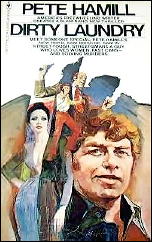
Sam Briscoe, 200 pounds of Irish Jew, is not a private eye, but a newspaper reporter — very nearly the next best thing, as I’ve implied before — presently free-lancing, but once a top columnist for a New York paper. (Hamill makes no secret of the fact that he regards this series as an integral part of his imaginary autobiography.)
A one-time girl friend calls on Sam for help, but on her way to him she’s smashed up while crossing the Brooklyn Bridge. The night is cold, and Sam has no idea that the killer’s trail will soon be leading him into sunny Mexico, and involve him deeply in the affairs of some renegade revolutionaries from Cuba.
And thereby all the ingredients of the traditional hard-boiled paperback novel are here — crime, passion, greed, lust, and revenge; the fire isn’t. And yet, if your taste runs toward the fulfillment of adolescent male fantasies, I think you’ll like it just fine.
Rating: C plus.
[UPDATE] 03-15-11. I had the impression back in 1979, that Sam Briscoe was going to hang around as a character a lot longer than he did, which was only two three books.
Of course with a line like the one below, excerpted from an online biography, you can understand that the writing of PBO mysteries was not going to be a career-changer for him:
“He [Pete Hamill] has been a columnist for the New York Post, the New York Daily News, and New York Newsday, the Village Voice, New York magazine and Esquire. He has served as editor-in-chief of both the Post and the Daily News.
And as they say, there is more, much more. The Sam Briscoe books are not mentioned.
From the Revised Crime Fiction IV, by Allen J. Hubin:
PETE(r) HAMILL. 1935- .
Dirty Laundry (n.) Bantam 1978 [Sam Briscoe]
The Deadly Piece (n.) Bantam 1979 [Sam Briscoe]
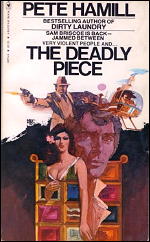
The Guns of Heaven (n.) Bantam 1983. [the third Sam Briscoe adventure; see comments]
Mon 14 Mar 2011
SEABURY QUINN – Alien Flesh. Oswald Train; hardcover, 1977. Introduction by E. Hoffman Price; illustrations by Stephen Fabian. Expanded from the short story “Lynne Foster Is Dead!”, Weird Tales, November 1938.
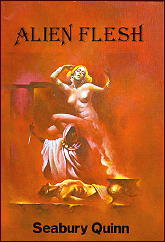
There is a type of book that can only be called a peculiar classic; not a work of great literature, and yet both memorable and remarkable. Inevitably such books are faintly redolent of the decadent, faintly touched with the strange; Huysman’s La Bas and Against the Grain are such books, so were the works of E. H. Visiak and William Beckford, so Mari Corelli’s The Sorrows of Satan, and James Branch Cabell’s Jurgen. Everything William Morris wrote falls under this umbrella and most of Lord Dunsany.
And so does Seabury Quinn’s Alien Flesh.
Seabury Quinn reigned supreme in the old pulp Weird Tales. The popularity of his tales of psychic sleuth Jules de Grandin and his Watson, Dr. Trowbridge, far surpassed the popularity of H. P. Lovecraft, Robert E. Howard, Robert Bloch or any of the other legendary names associated with the magazine. He even produced one genuine classic, the haunting Christmas story Roads (the legendary Arkham House edition illustrated by science fiction master Virgil Finlay is one of the most attractive books ever printed by a small press)..
Alien Flesh is a novel, written after Weird Tales glory days, in 1950 not long before the series of strokes that ended Quinn’s fiction writing career. He lived until 1969, but no longer churned out tales of vampires, werewolves, cults, and covens, and only one book like Alien Flesh. Not that there could be more than one book like Alien Flesh.
She came slowly toward them passed the rows of glassed-in mummy cases. She was not tall, but very slim, with the force maigruer of youth, and wore a daringly low-cut evening gown of midnight blue and a blonde knee length mink coat draped crosswise across her shoulders. Her eyes were amber and her honey colored hair was drawn back from a pronounced widow’s peak to be looped in a loose figure eight at the nape of her neck … she was like Clytie in a velvet gown, Titania in pearls and mink. If she had suddenly unfolded moth- wings and taken flight Arundel would not have been too much surprised.

Hugh Arundel, Egyptologist, attending a new Egyptian exhibit at a New York museum is introduced to the fabulous Madame Foulik Bey, Ismet.
And something draws Arundel to her, something in her strange manner, and stranger eyes, something he can’t quite put a finger on.
In short order his life revolves around her. She becomes the axis all aspect of his thoughts turn on. And at every turn a new mystery, her nature possessing, “as many facets as a diamond.”
And yet despite her obvious feeling for him she holds him at bay.
Finally he pushes her and she relents and tells him her story,
Lynne Foster was a boyhood friend. They had gone to school together, dated together, both been fascinated with Egypt. Lynne Foster had disappeared in Cairo, possibly murdered.
“Here is the ending!” she knotted her small hands into fists and struck herself on the breast. Her head was thrown back, and her eyes were flushed with tears. “I am — or was — I don’t know which — Lynne Foster.”
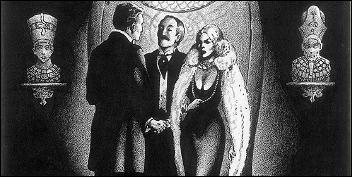
And then she relates her — Lynne Foster’s — tale.
I did warn you this was a peculiar classic.
Lynne Foster in Egypt fell afoul of ancient sorcery, and in his western arrogance was punished. He was transformed, from the strong and tough minded young man to …
Besides me there was no one else in the room!
As you might imagine this could go wrong very quickly, and it is a testament to the old pulp master’s skills that it does not. He finds a fine balance between horror, humor, whimsy, unabashed Arabian nights, the erotic — suggested but never spelled out — and sensuality — the book drips with that — as he spins out the tale of the fortunes of Lynne Foster, now Ismet a simple harem girl.
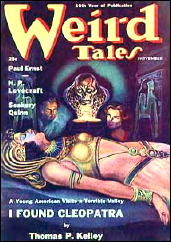
Again, I said this was a peculiar book and it is difficult to convey to any reader how well Quinn handles this difficult theme without slipping into either soft porn or outright comedy. The book recounts Ismet’s adventures, her first touches of romance in her new body, her battle with the mind of Lynne Foster and the emotions of the woman Ismet, and her rise to riches and power using Lynne Foster’s masculine mind and Ismet Foulik’s feminine charms.
I’m not sure I buy the sweepingly romantic ending, but Quinn more than prepares you for it, and after all, Hollywood used to churn out this kind of fantasy with regularity — though usually in the form of Thorne Smith comedy such as Turnabout or I Married A Witch.
Here it is deadly serious, but handled so deftly that the giggles that could easily turn to guffaws and destroy the entire mood are held at bay (at least while you are caught in Quinn’s spell, I can’t answer for later) and the reader manages to stay with Quinn thanks to his sheer story telling skills.
Once he gets you on his side he keeps you there, and plays deftly with both the reader’s willingness to suspend disbelief and also the key to any storyteller’s success, the readers desire to see what happens next. Quinn knew how to spin a tale and keep the pages turning, and here those skills serve him well. This isn’t the sort of book that can survive much in the way of the reader stopping to meditate on the story.
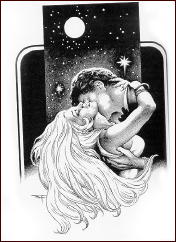
When this was reissued in 1977 by Oswald Train it came with an appreciative forward by Quinn’s friend and former pulp master E. Hoffman Price, a beautiful color cover by illustrator Stephen Fabian, and a full accompaniment of full page black and white illustrations also by Fabian. It’s a lovely little book and a perfect tribute to this most peculiar of peculiar classics.
I know many of you reading this description of the book, are going to say there is no way it could work in the form Quinn gives it, and no doubt it would not for many readers, but Alien Flesh, given half of a chance earns it’s place on that shelf of peculiar classics, and earns Quinn this much from me — I can’t think of another writer who could have pulled it off with half the charm, skill, and old fashioned pulp romanticizing.
If nothing else you turn each page just to see if he avoids the obvious traps — which he always does — and you reach the end glad to give him his choice of endings thankful for the memorable trip.
And one more peculiar classic finds its way onto the shelves.
Mon 14 Mar 2011
“Bed of Roses.” An episode of The Alfred Hitchcock Hour (Season 2, Episode 29). First air date: 22 May 1964. Patrick O’Neal, Kathie Browne, Torin Thatcher, George Lindsey, Alice Backes, Alice Frost, Bill Walker, Paulene Myers, Robert Reiner, Ethel Griffies.
George Maxwell (Patrick O’Neal) has it all: a comfortable, undemanding, high-paying position in his father-in-law’s business (Torin Thatcher), a nice home, and a beautiful airhead trophy wife, Mavis (Kathie Browne).
But that still isn’t enough for George. He also has a mistress — or rather, HAD a mistress. George wakes up one hungover evening to find her dead — and he’s not sure if he’s responsible.
Let’s face it: George is ill-equipped to handle this situation. Not only does he accidentally open himself to blackmail from a snoopy cab driver and a personal secretary, but he also shows how inattentive he is as a husband.
George, you see, is about to have an epiphany regarding his wife, one that will leave him slack-jawed with surprise and swollen with admiration. Among other revelations, he will learn that when his wife offers somebody one of her delicious sugar-molasses cookies, they would be well-advised to turn it down….
Patrick O’Neal (1927-1994) specialized in shifty, unlikable, yet somehow elegant characters, such as the killer in the Columbo episode “Blueprint for Murder” (1972).
Beautiful Kathie Browne (1930-2003) had “range” as an actor. She could be good with doe-eyed innocence; she could also be bad with those same doe-eyes. Watch her in the Star Trek episode “Wink of an Eye” to see what I mean.
Torin Thatcher (1905-1981) often played screen villains; he rarely had a chance to be a good guy like his character in the Star Trek episode “The Return of the Archons.”
George Lindsey (born 1935) is most often remembered as Goober on The Andy Griffith Show. Before he got that gig, though, he had a chance to play more complex and sinister characters in two other Hitchcock shows: “The Jar” and “The Return of Verge Likens.”
Watch “Bed of Roses” online at Hulu.com here.